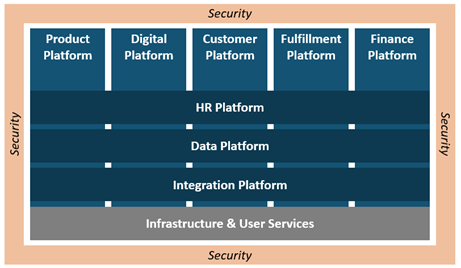We are always looking for ways to improve the customer experience. This involves making sure that our technology infrastructure can keep up with the ever-changing demands of our customers.
We initiated a technology transformation journey leveraging modularity to help us deliver value with more flexibility and agility. Rest assured, this article does not share only on microservices and other buzzwords but mainly on the value of technology to accelerate business changes.
In this article, we will discuss how modularity helps us deliver value in a context of uncertainty and some of the key principles that guide our transformation governance.
The Need for Modular Technology Transformation
As customers’ needs change, so does the technology they demand. And that rhythm of change is only accelerating with faster innovation cycles and increased competition. In that context, we need to be able to iterate quickly and with maximum flexibility.
Our initial architecture was monolithic on mainframe systems that became legacy over time but that were still supporting the majority of the business. The inherent coupling of functions, data, and rules makes it hard to evolve with the years of history, requiring us to change.
This is where modularity comes in.
By breaking our technology down into smaller, more manageable modules, we can deliver incremental changes with more flexibility, fewer risks, and shorter timings. As a result, we can perform more experiments to improve our value proposition with software.
But modularity is not only a technological question. It all starts by embedding modularity into the enterprise architecture, that is, the business, processes, and organization supporting our operations.
That’s why we are driving La Redoute platform transformation through an IT Blueprint that has been and is co-animated transversally in the organization—not only by “IT” or “Tech” teams.
We are all contributing to reinventing our company to become a true digital platform through modularity.
Our Vision of a Modular Business Platform
A modular business platform can be connected to a wide variety of users and partners with maximum flexibility. Compared to legacy organizations that take multiple months to connect to a single partner, a modular business platform connects to multiple ones in a matter of days or weeks.
Building a modular business platform requires defining a clear vision of the company’s future: the key development areas, the stable points, and which existing “business modules” require a more granular approach than they have today.
For La Redoute, our business platform modularity divides into two perspectives :
• Macro with main platforms (5 business, 3 technology , and 1 Data platforms)
• Local inside each platform has its own set of modular components.
 At a macro level, the first level of modularity enables a separation of concerns at the level of the business operations, integration, and operations.
At a macro level, the first level of modularity enables a separation of concerns at the level of the business operations, integration, and operations.
A concrete example is to dedicate the digital platform to omnichannel experiences, decoupling it from the product, payment, and ordering layers. A concrete example is to dedicate the digital platform to omnichannel experiences, decoupling it from the product, payment, and order layers.
Another change is to break the historical “order to parcel” paradigm. We have been used to retail e-commerce, but La Redoute now provides services on top of products and delivers more complex models such as drop-shipping, B2B, B2B2C—hence the separation of order and fulfillment platforms.
The last value of modularity is to support our international growth through a Unified platform. Software modules core to all countries can be rapidly deployed and scaled in a replicable way, while local adaptations for country specifics can be isolated in specific modules, maximizing our speed.
Unified software We build business modules with a core business behavior, where specific adaptations are made in modules. But all these ideas remain on paper without a technology platform.
The Alignment of our Technology Platform
The technology platform at La Redoute is directly cascading from the business platform vision. This alignment enables us to communicate on a shared picture of where the company is going as one team, avoiding the pitfall of implementing “technology for technology”.
On the macro level, the main objective of the business platforms is to offer modular services decoupled from each other to ease parallel implementations. This is achieved through explicit functional interfaces communicating through asynchronous technology layers.
A concrete example is the Order Platform exposing a set of unified services that can take La Redoute orders from any supported channels, business models, or partners. Then, it is the Order platform’s responsibility to find the best fulfillment execution without the Digital Platform knowing.
 At a local level, modularity becomes even more concrete. Software components are packaged to perform specific business functions and expose concrete business services through APIs. Each service is part of our referential to keep track of the big picture.
At a local level, modularity becomes even more concrete. Software components are packaged to perform specific business functions and expose concrete business services through APIs. Each service is part of our referential to keep track of the big picture.
The concrete technology transformation of the modularity imperative is to deliver smaller software modules with more manageable software increments to drive the business transformation step-by-step. That’s a change in paradigm as we were used to larger increments over multiple quarters.
And driving that mindset change of granularity requires governance.
The Governance of a Modular Platform
Strong governance is an important predictor of a transformation’s success. Driving changes in the overall business and technology scope requires commitment from the executive committee but also from influencers, leaders, and managers across the organization.
The first level of governance we have is a “Business Transformation” one, owning the priority and requirements authority over the projects we commit for the coming months. The goal is to select and rank key business priorities to define the platform modules to implement or adapt.
Then comes the technology governance orchestrating the required business changes and necessary IT & Data evolutions. The central part is the design authority through architecture reviews to ensure that modular changes and components will be implemented.
Then comes the technology governance that orchestrates the required business changes and necessary IT & Data evolutions. The central part is the design authority through architecture reviews to make sure that modular changes and modular components will be implemented.
One practice we build over time through our architecture review process is the concept that I name “Minimum Viable Move”. It consists of a systematic assessment and challenge of proposed software changes to maximize value, and flexibility and keep the risks low.
Through minimum moves, we are building our modular business platform.
The Next Steps of our Modular Platform
The implementation of our modular platform has been accelerating since 2022 to shape the business platforms through concrete software increments like a streamlined financial platform with SAP, an express checkout experience through micro front-end with a reactive experience.
Our main transformational focus is to deliver the foundations of unified APIs to decouple the main platforms. These technological components are the ones that will power modular services with our users and partners but also enable us to drive more parallel changes in each platform.
This transformation focus is what drives us for the months and years to come to transform our company into the perfect blend for your Homelife platform, where modularity is, and will be, one of the attributes to accelerate our company reinvention through software.

